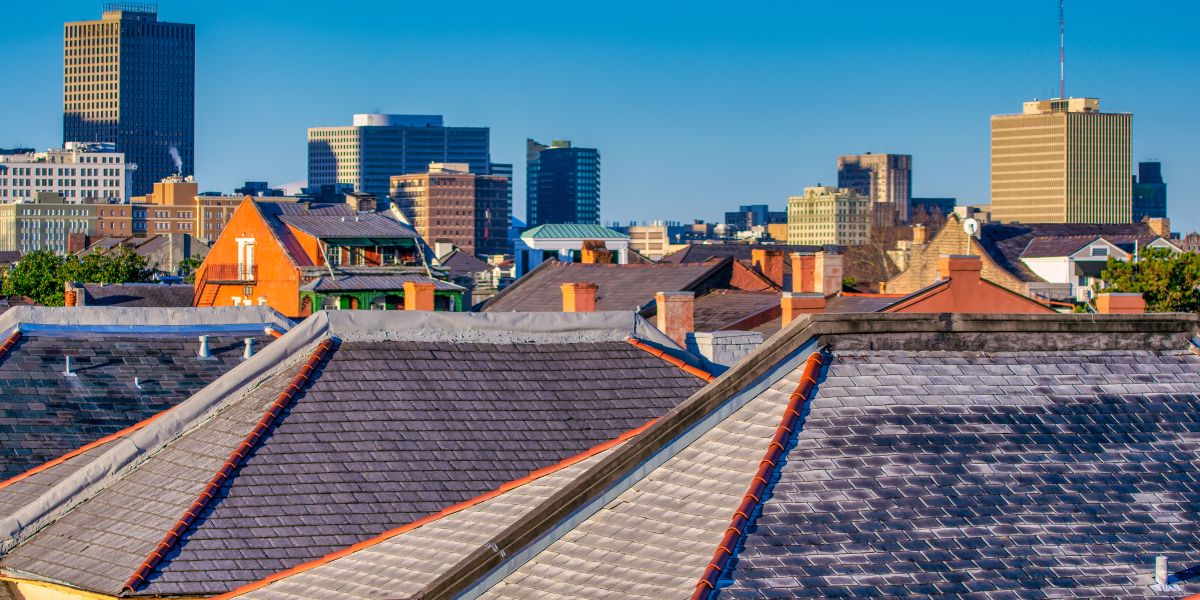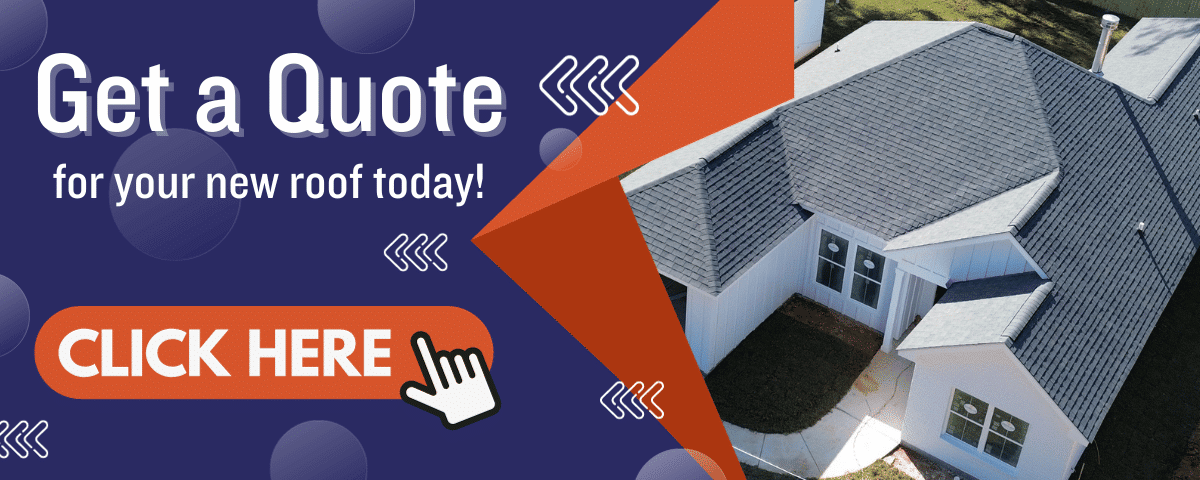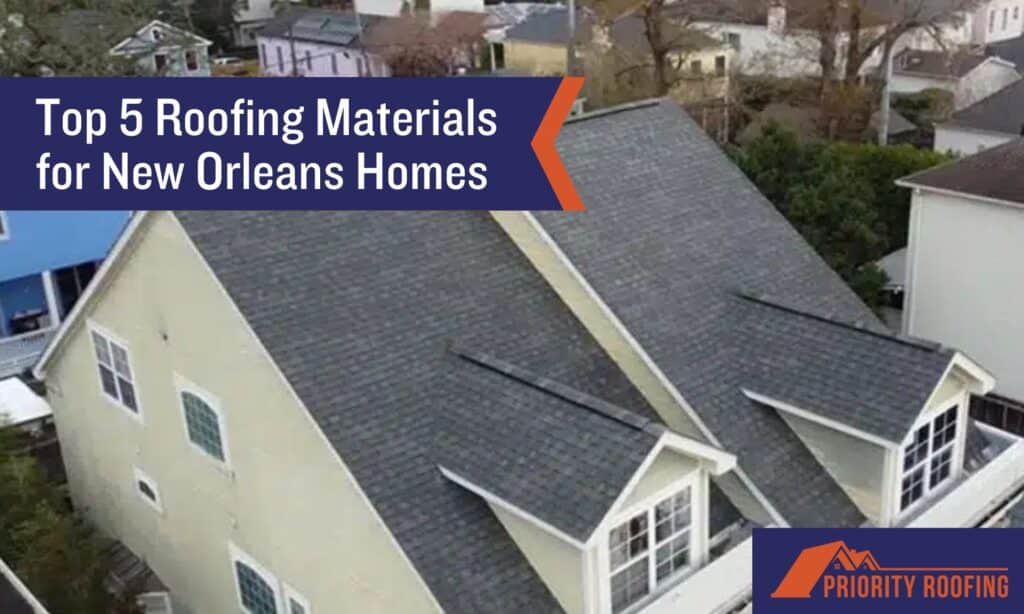Protecting Your Home from Heat, Humidity, and Hurricanes
When it comes to protecting your home in New Orleans, Priority Roofing understands that your roof and the roofing materials it’s built with make a difference. With over 50 years of combined experience in roofing and construction, we know what it takes to shield your family from heavy rains, endure scorching heat, and withstand hurricanes. That’s why we’re proud to be a trusted partner in safeguarding homes across the Gulf South.
High humidity, intense heat, and the occasional hurricane can wreak havoc on unprepared roofs. Choosing the right materials protects your residential roofing and can save you thousands in repairs down the road. So, what are the best roofing materials for homes in the Crescent City?
In this guide, we’ll explore the top five roofing materials designed to handle New Orleans’ unique climate. Let’s dive in and find the perfect fit for your homes.
Challenges for Roofing Materials in Humid Climates
At Priority Roofing, we’ve seen firsthand how the Gulf South’s weather impacts roofing materials. Between intense summer heat and near-constant moisture, your roof faces challenges that demand durability and proper maintenance. Here’s a closer look at what makes this climate so tough on roofs:
1. High Humidity and Moisture Issues
New Orleans is famous for its sweltering humidity, which can create the perfect breeding ground for mold, mildew, and rot. Roofing materials that absorb moisture or lack proper sealing can deteriorate quickly under these conditions.
2. Intense Heat and UV Exposure
The relentless Louisiana sun doesn’t just make summers uncomfortable; it also bakes roofs, leading to cracks, fading, and reduced lifespans of certain materials. Reflective roofing materials can help combat this issue by reducing heat absorption.
3. Heavy Rain and Hurricanes
The Gulf Coast sees its fair share of storms, and roofs in New Orleans must endure torrential downpours and high winds. A strong, weather-resistant roof must protect your home from water intrusion and structural damage.
4. Risk of Mold, Algae, and Staining
Dark stains and streaks on roofs in humid climates often come from algae and mold growth. These not only look unsightly but can also weaken roofing materials over time.
New Orleans homeowners need roofing solutions that can withstand these challenges. Priority Roofing has helped homeowners navigate these challenges for over a decade with tailored roofing solutions. In the next section, we’ll explore the top five materials that can withstand the heat and the humidity!

Top 5 Roofing Materials for New Orleans Homes
At Priority Roofing, we understand that roofing materials vary significantly, especially when addressing New Orleans’s unique climate challenges. With over a decade of experience protecting homes throughout the Gulf South, we have identified the top five roofing options that excel in durability, weather resistance, and performance in high-moisture environments. These materials are carefully selected to ensure your roof can withstand the heat, humidity, and storms characteristic of life in New Orleans.
1. Asphalt Shingles
Many homeowners choose asphalt shingles due to their affordability and versatility. While standard varieties may struggle in humid conditions, Priority Roofing offers modern options like algae-resistant shingles, which offer added protection against mold and staining.
- Benefits: Cost-effective, widely available, and easy to install.
- Considerations: Opt for moisture-resistant types to ensure longevity in humid climates.
- Ideal for: Budget-conscious homeowners who want reliable performance.
2. Metal Roofing
Metal roofing shines—literally and figuratively—in humid and storm-prone climates. Its reflective properties reduce heat absorption, while its non-porous surface resists moisture and mold growth.
- Benefits: Durable, lightweight, and low maintenance.
- Considerations: Higher upfront cost but long-term savings on energy and repairs.
- Ideal for: Homes looking for energy efficiency and modern aesthetics.
3. Clay or Concrete Tiles
These heavy-duty tiles have been used for centuries in hot, humid regions, and for good reason. Their natural ability to resist moisture and withstand extreme temperatures makes them an excellent choice for New Orleans homes.
- Benefits: Longevity (50+ years), great for high-heat areas, and rot-resistant.
- Considerations: Heavier than other materials, requiring structural solid support.
- Ideal for: Homeowners seeking a timeless look with unparalleled durability.
4. Slate Roofing
Slate is the gold standard for durability and resistance to the elements. Its dense structure repels moisture and endures the test of time, often lasting over a century.
- Benefits: Highly durable, elegant appearance, and resistant to mold and algae.
- Considerations: Expensive and heavy, requiring professional installation and support.
- Ideal for: Premium homes where longevity and aesthetics are top priorities.
5. Synthetic Roofing Materials
Synthetic options like rubber, polymer, or composite shingles mimic the look of natural materials while offering enhanced durability. They’re often treated to resist mold, algae, and weather damage.
- Benefits: Lightweight, affordable, and resistant to moisture and staining.
- Considerations: Quality can vary; choose a reputable manufacturer.
- Ideal for: Homeowners who want a balance of affordability and resilience.
Each of these materials offers unique advantages for homes in New Orleans. The right choice depends on your budget, aesthetic preferences, and specific needs.

How to Choose the Right Roofing Material
With so many great options, picking the best roofing material for your New Orleans home can feel overwhelming. To make an informed decision, consider these key factors:
1. Budget
Start by determining how much you’re willing to invest in your roof. While asphalt shingles offer a cost-effective solution, premium options like slate or metal roofing may be worth the extra expense for their longevity and energy efficiency.
2. Climate Compatibility
The humid, hot weather in New Orleans demands materials that resist moisture, mold, and heat. Avoid porous options or untreated wood shingles, as they can quickly deteriorate in this environment.
3. Aesthetic Appeal
Your roof plays a significant role in your home’s curb appeal. Whether you love the rustic look of clay tiles or the sleek finish of metal panels, choose a material that complements your home’s style.
4. Longevity
If you plan to stay in your home long-term, investing in durable materials like slate or metal roofing can save you money. For shorter-term needs, asphalt shingles or synthetic options can provide excellent value.
5. Professional Advice
Every home is unique, and a local roofing expert can provide personalized recommendations based on your specific needs and budget. They’ll also ensure your roof complies with New Orleans building codes and withstands local weather conditions.
Selecting the right roofing material isn’t just about aesthetics or price—it’s about finding a solution that will protect your home and withstand the unique challenges of New Orleans weather.
Why Trust Priority Roofing?
Since 2012, Priority Roofing has been committed to safeguarding homes across the Gulf South. From Baton Rouge to Biloxi, our team of local experts is ready to provide customized solutions that meet your home’s specific requirements. We offer free estimates and professional advice to help you choose the best roofing materials suited for New Orleans’ unique climate.
Maintaining Your Roof in Humid Climates
Even the best roofing materials need proper care to stay in top condition—especially in New Orleans’ humid climate. Regular maintenance can prevent costly repairs and extend the lifespan of your roof. Here’s how to keep your roof in great shape:
1. Schedule Regular Inspections
A professional roof inspection at least twice yearly (spring and fall) helps identify potential issues early. It’s also a good idea to schedule an inspection after severe weather events like hurricanes or heavy storms.
2. Keep Your Roof Clean
Humidity and moisture encourage mold, algae, and lichen growth, which can damage your roof over time. Use a soft brush or low-pressure washing to clean your roof periodically. Look for roofing materials with algae-resistant coatings for added protection.
3. Maintain Proper Ventilation
Good attic ventilation reduces moisture buildup, preventing mold growth and protecting your roof’s structural integrity. Ensure your vents are unobstructed and functioning correctly.
4. Clear Gutters and Downspouts
Clogged gutters can cause water to back onto your roof, leading to leaks and water damage. Clean your gutters regularly, especially during the fall when leaves are more likely to collect.
5. Trim Overhanging Branches
Trees hanging over your roof can drop leaves and debris, which trap moisture and encourage mold growth. Keep branches trimmed to minimize debris and reduce the risk of damage during storms.
6. Address Minor Repairs Promptly
Don’t ignore small issues like missing shingles or minor leaks. If left untreated, what starts as a minor problem can quickly escalate into a costly repair.
A well-maintained roof can withstand New Orleans’ challenging climate, protecting your home and saving you money in the long run.

Protecting New Orleans, One Roof at a Time
Your roof is more than just a shield against the elements—it’s a vital investment in your home’s safety, comfort, and value. Choosing a suitable roofing material is essential in a city like New Orleans, where high humidity, heavy rains, and intense heat are part of life.
From cost-effective asphalt shingles to premium slate and energy-efficient metal roofing, the options we’ve covered are built to handle the unique challenges of humid climates. Pairing the right material with regular maintenance will ensure your roof remains a sturdy, dependable barrier for years to come. These recommendations reflect our commitment to providing roofing solutions that not only protect your home but also enhance its value and longevity.
If you’re ready to protect your home with the best roofing materials for New Orleans, don’t go it alone. Consult a local roofing expert to assess your needs and guide you to the perfect solution. With their help, you can weather any storm. Trust the roofing experts who know New Orleans best—choose Priority Roofing to ensure your home stays safe and secure.
FAQ’s
1. Are any roofing materials “hurricane proof”?
While no roofing material is entirely hurricane-proof, some options are better suited for high-wind and storm-prone areas like New Orleans. Metal roofing, for example, is highly wind-resistant and can be secured with fasteners to withstand severe storms. Concrete tiles and slate are also durable options when installed correctly to avoid damage. Always consult a professional to ensure your roof meets local building codes for hurricane resistance.
2. What’s the most affordable roofing material for humid climates?
Asphalt shingles are one of the most cost-effective options for homeowners. Consider algae-resistant varieties that prevent mold and staining, making them suitable for humid climates.
3. How often should I clean my roof in New Orleans?
In a humid environment, you should clean your roof at least once a year to remove debris, mold, and algae. More frequent cleaning may be necessary if your roof is shaded or prone to debris accumulation.
4. How can I tell if my roof needs repairs or a complete replacement?
Look for signs like widespread water damage, sagging, or missing shingles. If your roof is nearing the end of its lifespan (20–30 years for asphalt shingles, for example), it might be time for a replacement. A professional inspection can provide clarity.
5. What roofing material lasts the longest in humid climates?
Slate and metal roofing are among the longest-lasting materials, with lifespans of 50+ years. Their durability and resistance to moisture, rot, and mold make them ideal for humid environments. Contact Priority Roofing for a free inspection.

